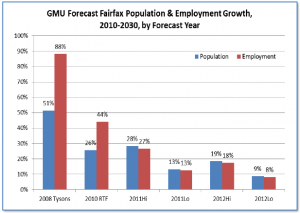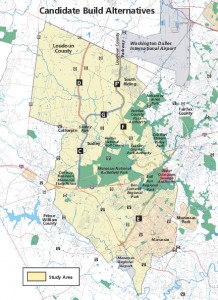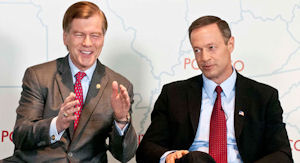by James A. Bacon
I don’t know whether to laugh or cry. Buried within the massive Six Year Improvement Program approved by the Commonwealth Transportation Board (CTB) last week was a line item that provides $5 million for preliminary engineering and design of the Bi-County Parkway (BCP). The parkway, the dream of a vocal element of the Northern Virginia business community, is widely seen as a preliminary step in creating an outer beltway for the Washington metropolitan area.
The Northern Virginia Transportation Alliance lauds the progress on the parkway, which would extend Rt. 234 in Prince William County all the way to Rt. 50 in Loudoun County. “In addition to connecting employment centers and residential communities in Northern Virginia’s second and third largest jurisdictions the Parkway provides a critical (and currently missing) link for travelers and freight to and from Washington Dulles International Airport, one of Virginia’s most important economic engines,” said the alliance in an email distributed last week.
I am tempted to laugh because the sum is so piteously small, no more than a sop to Northern Virginia’s development and construction interests. Yet I am moved to cry because that $5 million is utterly wasted. While one could have made a semi-plausible case during the 2000s real estate boom that the region would one day need a north-south corridor on the western fringe of the Washington metropolitan area, no such case can be made today. The dynamics of metropolitan growth and development have totally changed. Growth in Northern Virginia is (a) slowing and (b) moving back to the urban core. Infrastructure spending should be steered to supporting that growth, which is actually happening, not squandered on anticipating development that may or may not ever happen.
A few reminders from previous posts…
 Northern Virginia population growth is slowing, and the prospect of restrained federal government spending — if not an outright collapse in federal spending — will reduce the demand for workers and all the housing, office and retail infrastructure that supports them. The experts have trimmed their growth forecasts in recent years, as can be seen in this chart published in a previous post. (See “Fairfax County’s Incredible Shrinking Growth Forecast.”)
Northern Virginia population growth is slowing, and the prospect of restrained federal government spending — if not an outright collapse in federal spending — will reduce the demand for workers and all the housing, office and retail infrastructure that supports them. The experts have trimmed their growth forecasts in recent years, as can be seen in this chart published in a previous post. (See “Fairfax County’s Incredible Shrinking Growth Forecast.”)
The exurbs have lost their allure. In metropolitan areas across the country, property values are gaining value in the dense urban core and losing value in the low-density periphery. (See “Exurbs in Agony.”) Declining property values have boosted the rate of foreclosures. Bottom line: There is surplus housing supply on the urban edge. There is no need to build much more.
Population growth has shifted to core jurisdictions. Consumer preferences are changing. People increasingly want to live in walkable, mixed use communities, ideally with access to mass transit. Empty nesters seek access to the cultural amenities that reside in the urban core. Saddled with college debt and more likely to be unemployed or underemployed, Gen Y is not buying into the American Dream of a house in the burbs with a two-car garage. (See “Population Growth Shifting to Cities.”)
The market is glutted with land available for development. There is no need to open up more land on the metropolitan fringe because so much property is available for development and re-development closer to the urban core. Fairfax County has embraced an Arlington-style strategy of increasing density around its METRO stops. Building is booming around the existing Dunn Loring-Merrifield METRO station, and developers are preparing for the opening of the Silver Line to Tysons Corner and beyond. Mixed-use re-development at higher densities is all the rage.
The only semi-plausible argument advanced by the Northern Virginia Transportation Alliance is an economic development one — the bi-county road would help serve growing air freight traffic at Dulles. If Bi-County Parkway backers can make a persuasive case that the road could pay its own way through tolls, I’d be open to their argument. But if the road would require massive state subsidies like the proposed U.S. 460 Connector in southeastern Virginia, that’s a pretty good signal that the economics don’t work.




